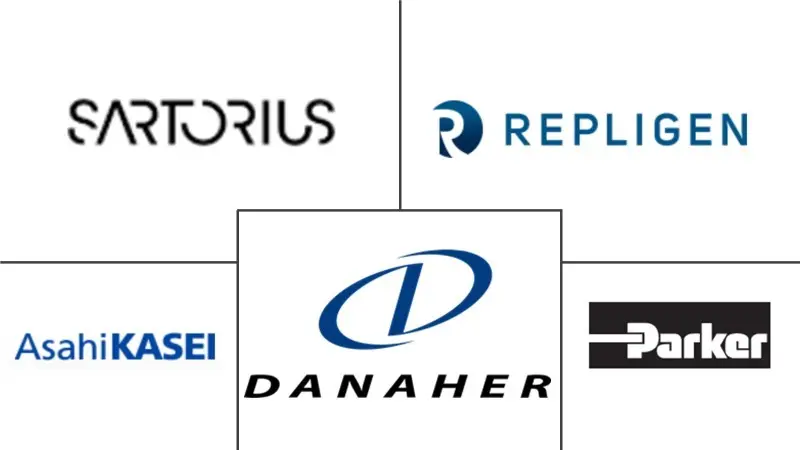Hollow Fiber Filtration Market Size and Share
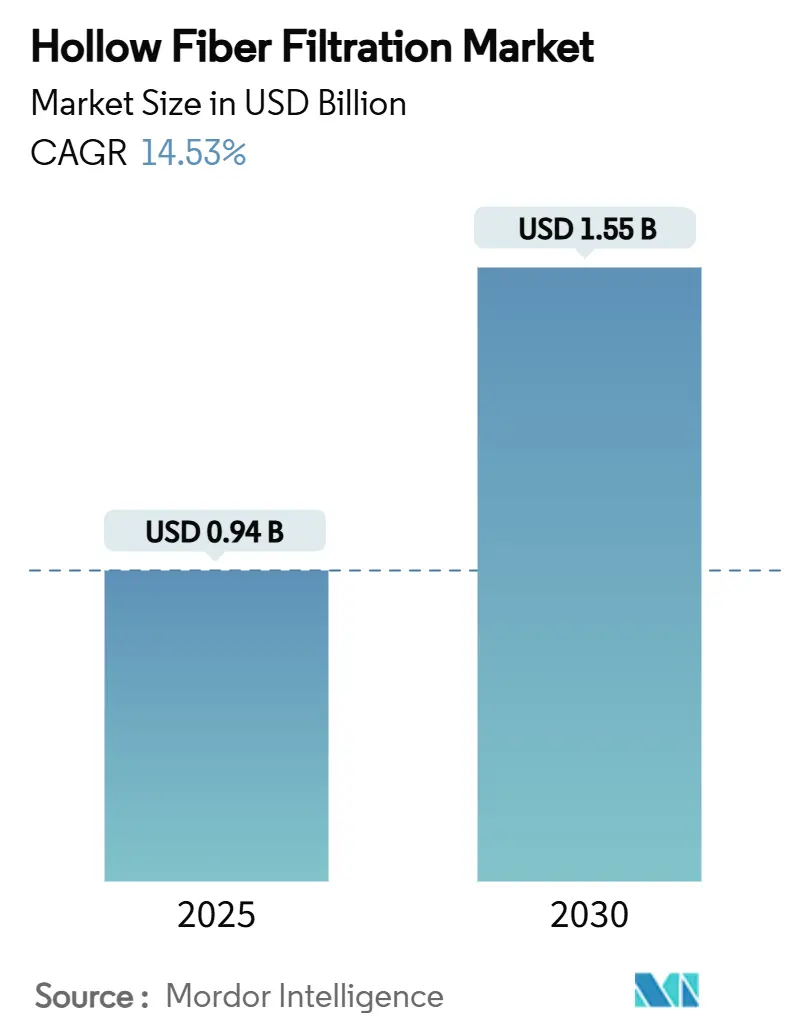
Hollow Fiber Filtration Market Analysis by Mordor Intelligence
The hollow fiber filtration market size stands at USD 0.94 billion in 2025 and is projected to reach USD 1.55 billion by 2030 at a 14.53% CAGR, underscoring the rapid modernization of global bioprocessing capacity. Intensifying biologic pipelines, the pivot toward continuous manufacturing, and the migration to single-use equipment collectively reinforce demand for robust membrane platforms that maintain high cell density and product quality. Synthetic polymer membranes currently dominate, but ceramic variants are scaling quickly as manufacturers look to extend membrane lifetimes under harsher process conditions. On the process front, ultrafiltration is displacing microfiltration in critical separations, while contract development and manufacturing organizations (CDMOs) shift procurement toward modular, multi-product filtration skids. Regionally, North America still commands the largest installed base; however, escalating Asia-Pacific investments signal a geographic re-balancing of the hollow fiber filtration market in the next five years. Competitive intensity is rising as leading suppliers assemble end-to-end downstream portfolios through mergers and targeted R&D.
Key Report Takeaways
- By material, synthetic polymer membranes held 78.43% of hollow fiber filtration market share in 2024, whereas ceramic membranes are forecast to expand at a 16.75% CAGR to 2030.
- By technique, microfiltration led with 62.45% revenue share in 2024; ultrafiltration is projected to post a 16.83% CAGR through 2030.
- By end user, the pharmaceutical and biotechnology segment accounted for 66.34% of the hollow fiber filtration market size in 2024, while CROs and CDMOs are set to grow at a 17.56% CAGR between 2025-2030.
- By application, protein concentration and diafiltration captured 55.67% share of the hollow fiber filtration market size in 2024; raw material filtration advances at a 17.89% CAGR over the same period.
- By geography, North America captured 41.32% share of the hollow fiber filtration market size in 2024; whereas, Asia-Pacific is projected to grow at fastest CAGR 15.67%.
Global Hollow Fiber Filtration Market Trends and Insights
Driver Impact Analysis
| Driver | % Impact on CAGR Forecast | Geographic Relevance | Impact Timeline |
|---|---|---|---|
| Rapid Expansion of Global Biologic Drug Pipeline | +3.2% | Global (North America & EU focal) | Medium term (2-4 years) |
| Rising Adoption of Single-Use Bioprocess Equipment | +2.8% | Global, led by North America, expanding to APAC | Short term (≤ 2 years) |
| Shift Toward Continuous and Perfusion Manufacturing | +2.1% | North America & EU core, spill-over to APAC | Long term (≥ 4 years) |
| Growing Outsourcing to Contract Development and Manufacturing Organizations | +1.9% | Global, with APAC gaining prominence | Medium term (2-4 years) |
| Surge in Advanced Therapy Medicinal Product Commercialization | +1.7% | North America & EU, early adoption in APAC | Long term (≥ 4 years) |
| Emerging Demand for High-Purity Plant and Cultured Protein Processing | +1.4% | Global, with early gains in North America, EU, Singapore | Medium term (2-4 years) |
| Source: Mordor Intelligence | |||
Rapid Expansion of Global Biologic Drug Pipeline
More than 6,500 monoclonal antibodies were in clinical development in 2025 versus 360 commercialized molecules in 2024, triggering a step-change in filtration run volumes and development batches. Each therapeutic candidate requires scalable filtration solutions through clinical and commercial phases, intensifying orders for flexible hollow fiber modules that switch quickly between development scales. Complex formats—bispecifics and antibody-drug conjugates—raise selectivity needs that conventional microfiltration cannot meet consistently, prompting ultrafiltration adoption. Most pipeline growth now stems from Asia-Pacific sponsors, driving suppliers to build local technical support and membrane production hubs to stay competitive. Technology providers therefore prioritize integrated systems combining membrane modules with in-line sensing to support process validation and comparability across global sites.
Rising Adoption of Single-Use Bioprocess Equipment
Global single-use system sales expanded at more than 10% CAGR between 2019-2024, and hollow fiber cartridges optimized for disposability are capturing the upside. Eliminating clean-in-place cycles lowers capital outlay and validation costs, making advanced filtration affordable for emerging biotechs and cell therapy developers. Investments by Cytiva and Pall totaling USD 1.5 billion—including USD 300 million earmarked for single-use lines—demonstrate supplier commitment to pre-sterilized, gamma-stable membrane assemblies. Uptake accelerates in greenfield Asian plants that can specify single-use architectures from day one. Environmental scrutiny over plastic waste, however, is spurring R&D into recyclable housings and compostable polymers, inserting sustainability criteria into procurement decisions.
Shift Toward Continuous and Perfusion Manufacturing
Perfusion bioreactors attain roughly 10× higher viable-cell density than conventional fed-batch, demanding membranes that resist fouling during uninterrupted operation. Suppliers are refining lumen geometries, surface chemistries, and module hydraulics to sustain steady-state, 60-day campaigns without integrity breaches. Continuous processes also encourage inline monitoring: pressure-drop sensors and UV absorption probes feed control loops that trigger preventive maintenance, curbing unscheduled downtime. Regulators support the model because tighter control reduces lot variability, yet the switch brings higher upfront equipment spend and data-management overhead. Economic benefits are compelling; reported facilities achieve 30–35 g/L yields against 3 g/L in fed-batch over identical timeframes, cutting cost-of-goods even with premium membranes.
Surge in Advanced Therapy Commercialization
Advanced therapy medicinal products (ATMPs) are projected to climb from USD 8.4 billion in 2022 to USD 20.63 billion by 2031, ushering in small-batch, high-value workflows that depend on low-shear, high-selectivity hollow fiber filtration steps[1]“ATMP Cleanroom Facilities: A Roadmap for Success,” ISPE, ispe.org. ATMPs often require cell-friendly processing under strict aseptic controls, and hollow fibers provide gentle hydrodynamics compared with plate-and-frame devices. As regulators clarify ATMP guidelines, demand for validated, closed-loop filtration modules capable of handling living cells and viral vectors will intensify, positioning the hollow fiber filtration market for disproportionate upside in this segment.
Restraints Impact Analysis
| Restraints Impact Analysis | (~) % Impact on CAGR Forecast | Geographic Relevance | Impact Timeline |
|---|---|---|---|
| Stringent Regulatory Validation and Documentation Requirements | -2.3% | Global, highest impact in North America & EU | Long term (≥4 years) |
| Membrane Fouling Leading to Recurrent Replacement Costs | -1.8% | Global, particularly affecting high-volume lines | Short term (≤2 years) |
| High Capital Expenditure for Large-Scale Filtration Skids | -1.6% | Global, most acute for greenfield commercial plants | Medium term (2-4 years) |
| Performance Limitations with High-Viscosity Gene Vector Solutions | -1.2% | Global, pronounced in cell and gene therapy hubs | Short term (≤2 years) |
| Source: Mordor Intelligence | |||
Stringent Regulatory Validation and Documentation Requirements
FDA and EMA guidelines mandate exhaustive performance evidence for every membrane configuration, driving validation spend beyond USD 1 million per step on complex biologics[2]“Lifetime Studies for Membrane Reuse: Principles and Case Studies,” BioPharm International, biopharminternational.com. Smaller innovators lack specialized teams and often defer to CDMOs with proven filings, which slows direct equipment sales. Divergent regional rules—particularly around pre-use integrity testing—force dual studies, lengthening timelines by up to 18 months. Vendors with audit-ready data packages now enjoy preferential supplier status, but generating those dossiers is resource-intensive and raises barriers for new entrants.
Membrane Fouling Leading to Recurrent Replacement Costs
Protein deposits, cell debris, and lipid aggregates progressively clog pores, shortening module life and inflating variable costs. A single large-scale replacement can exceed USD 1 million, nullifying throughput gains if change-outs occur mid-campaign. Material scientists are experimenting with helical carbon nanotube-reinforced ceramic supports that maintain flux for extended runs and hit 99.99% oil-in-water separation in analogous tests[3]“Fabrication of Composite Membrane by Constructing Helical Carbon Nanotubes in Ceramic Support Channels,” Membranes Journal, mdpi.com. Pricing, however, remains premium and adoption concentrates in high-margin therapeutics. Broader roll-out hinges on validated anti-fouling coatings and cost-effective cleaning agents that do not trigger re-qualification protocols.
Segment Analysis
By Material: Ceramic Membranes Challenge Polymer Dominance
Synthetic polymers held 78.43% of hollow fiber filtration market share in 2024 thanks to mature supply chains and attractive unit costs. Within this cohort, polyethersulfone remains preferred for antibody purification owing to 4.52 L/m²·h·atm clean-water permeability and stable pH tolerance. Polyvinylidene fluoride gains in solvent-rich feeds, while polysulfone supports higher-pressure steps. Polypropylene persists where protein adsorption risk is low. Ceramic membranes, although still niche, are scaling at a 16.75% CAGR as plants seek longer life cycles and aggressive cleaning compatibility. Alumina and zirconia variants withstand caustic regimes and back-pulse procedures, reducing downtime in perfusion lines. Cost amortization over multi-year campaigns makes ceramics increasingly attractive as continuous processing expands, a trend that should raise their revenue share materially within the hollow fiber filtration market by 2030.
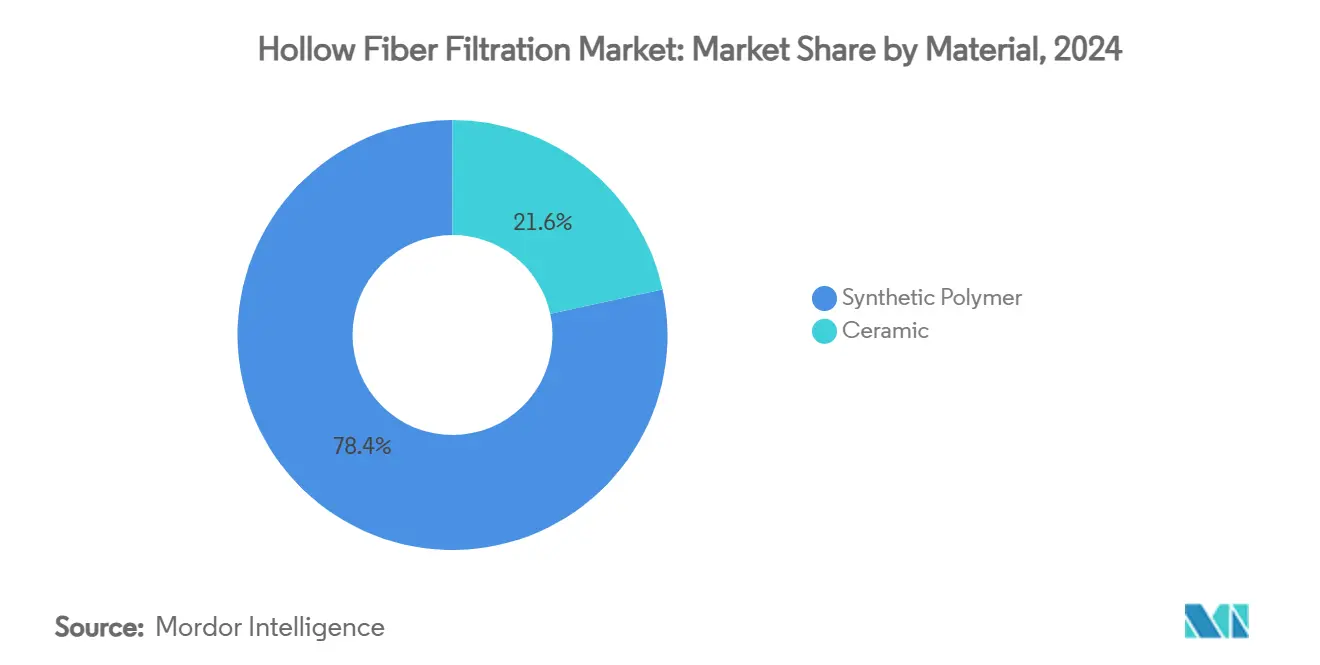
Note: Segment shares of all individual segments available upon report purchase
By Technique: Ultrafiltration Gains Precision Advantage
Microfiltration kept 62.45% revenue in 2024, driven by cell harvest and broth clarification tasks that fit its 0.1–0.45 µm cut-off range. Tangential-flow microfiltration (TFF) reigns in large-scale antibody plants, offering higher throughput than dead-end modes and proven regulatory lineage. The pivot to ultrafiltration, however, is unmistakable: at 16.83% CAGR, operators increasingly rely on 10–100 kDa membranes for buffer exchange and concentration, achieving >99.75% retention while trimming diafiltration volume. Single-pass configurations embedded in fully continuous platforms slash hold times and accelerate batch release testing, making ultrafiltration central to next-gen plant layouts. Suppliers differentiate via low-fouling chemistries and inline analytics that certify pore integrity in real time.
By End User: CROs Drive Market Expansion
Pharmaceutical and biotechnology manufacturers controlled 66.34% of hollow fiber filtration market size in 2024, leveraging deep regulatory know-how to operate in-house purification suites. Big Pharma megasite expansions—Novo Nordisk’s USD 4.1 billion US build-out among them—cement baseline demand for high-capacity modules. CDMOs and CROs, conversely, are edging toward 17.56% CAGR as outsourcing rationalizes capital deployment. These firms prefer standardized skid footprints compatible across monoclonal antibodies, recombinant proteins, and viral vectors, thereby fueling orders for plug-and-play hollow fiber cassettes. Academic and research institutes represent a strategic seeding ground: early adoption in cell therapy studies supplies critical performance data that often migrates into commercial specs, reinforcing vendor presence.
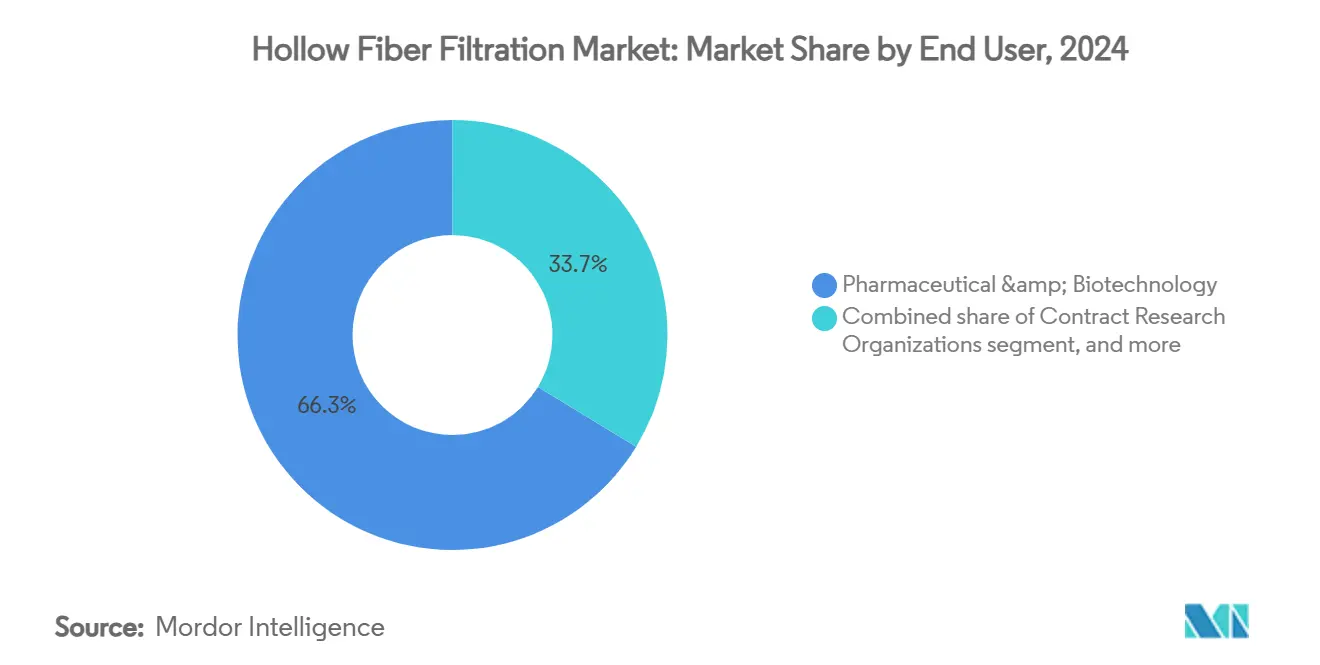
Note: Segment shares of all individual segments available upon report purchase
By Application: Raw Material Processing Accelerates
Protein concentration and diafiltration sustained 55.67% revenue in 2024, reflecting regulatory mandates for precise formulation of injectable biologics. Here, hollow fiber modules routinely enable 10-fold concentration with minimal shear, preserving IgG integrity and glycosylation profiles. Yet raw material filtration is surging at 17.89% CAGR as manufacturers tighten control over media and buffer inputs to pre-empt contamination events. High-flux fibers strip particulates and bioburden from cell culture components, improving downstream yield predictability. Virus and VLP production add further impetus: next-generation filters such as Asahi Kasei’s Planova FG1 operate at seven-times the flow rate of prior models, raising productivity for vaccine lines. Coupled with automation, these advances strengthen the hollow fiber filtration market’s role in upstream-to-downstream integration.
Geography Analysis
North America accounted for 41.32% of hollow fiber filtration market share in 2024 as decades of investment in Boston, San Francisco, and the Research Triangle reinforced a sophisticated supplier–user ecosystem. FDA guidance—clear on microbial retention, extractables, and integrity testing—speeds qualification of novel membrane chemistries. Fujifilm’s USD 1.2 billion expansion in North Carolina adding 160,000 L of bioreactor volume exemplifies continued regional capacity growth.
Europe sustains a sizeable presence led by Germany’s engineering strength and the United Kingdom’s cell-and-gene therapy cluster. The EMA’s environmental leanings promote ceramic membranes and reusable housings, while Horizon Europe funding channels pour capital into low-carbon bioprocess technologies. This policy framework both disciplines supplier claims and cultivates technology differentiation in sustainability metrics.
Asia-Pacific remains the fastest-growing area at 15.67% CAGR. China’s biopharma market is forecast to exceed 1.4 trillion yuan by 2029, and state grants favor domestic membrane manufacturing scale-ups, trimming lead times for local biotech startups. South Korea emerges as a regional export hub, underscored by MilliporeSigma’s EUR 300 million Daejeon plant that delivers sterile filtration consumables to a wider Asian customer base. Japan leverages precision ceramics expertise to supply ultra-smooth lumen surfaces for continuous lines, whereas Singapore positions itself as a regulatory sandbox for first-in-class filtration materials through fast-track approvals. Together these dynamics will gradually rebalance global revenue shares in the hollow fiber filtration market before 2030.
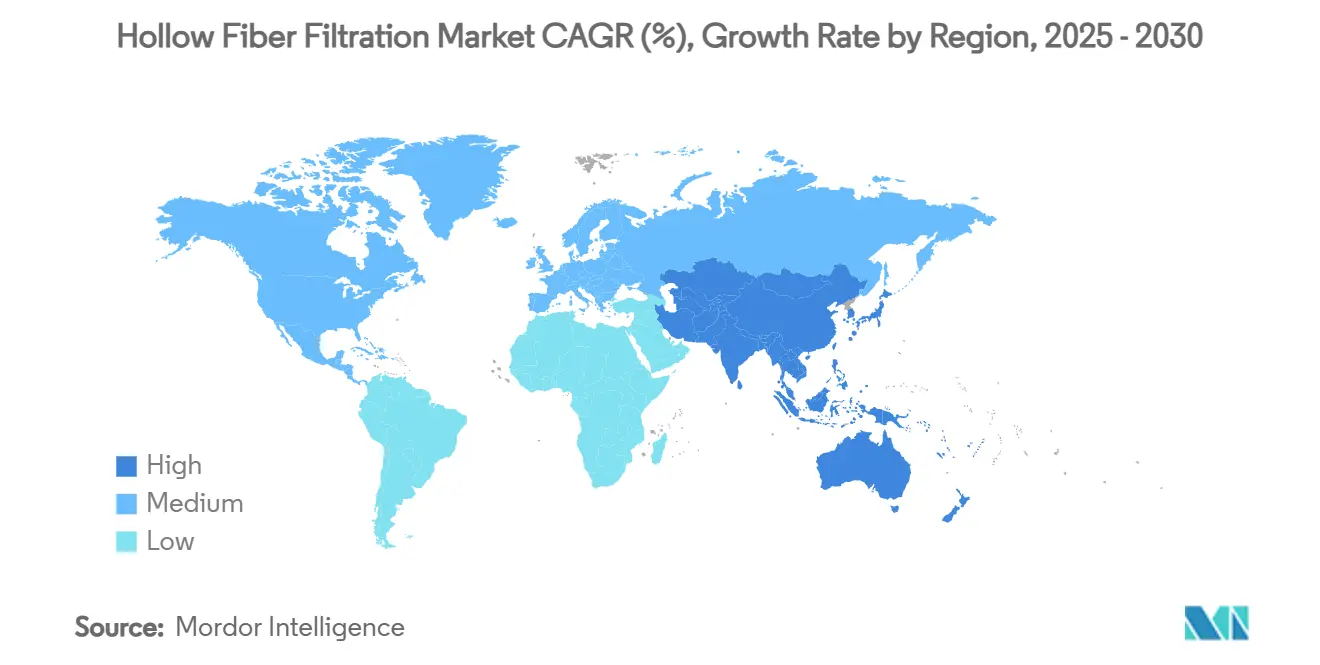
Competitive Landscape
Industry consolidation is quickening, pushing the hollow fiber filtration market toward integrated solution models. Thermo Fisher’s USD 4.1 billion purchase of Solventum’s purification division folds membrane cartridges, chromatography resins, and single-use assemblies into one portfolio, reinforcing one-stop bid capabilities for large capital projects. Danaher’s earlier fusion of Cytiva and Pall forged a USD 7.5 billion bioprocess powerhouse spanning upstream media through virus filtration, elevating cross-selling potential and after-sales support width.
Product innovation runs in parallel. Repligen channels R&D into smart hollow fiber modules embedded with optical sensors and cloud-connected controllers that monitor flux decline and trans-membrane pressure drift. Sartorius is localizing production via its new Center for Bioprocess Innovation in Greater Boston, trimming time-to-customer for customized membrane cassettes. In Asia, domestic challengers—Boln BioTech among them—secure venture funding to upscale ceramic and nanofiltration specialties, aiming to undercut imports while meeting regional GMP standards.
Service capabilities now differentiate front-runners: on-site validation, electronic batch-record integration, and 24/7 spare-part logistics weigh heavily in procurement scores. Suppliers that can shoulder regulatory documentation burdens for novel therapies win preferred-supplier status with resource-constrained developers, further concentrating share at the top.
Hollow Fiber Filtration Industry Leaders
-
Repligen Corporation
-
Parker Hannifin Corp
-
Asahi Kasei Co Ltd
-
Danaher Corporation
-
Sartorius AG
- *Disclaimer: Major Players sorted in no particular order
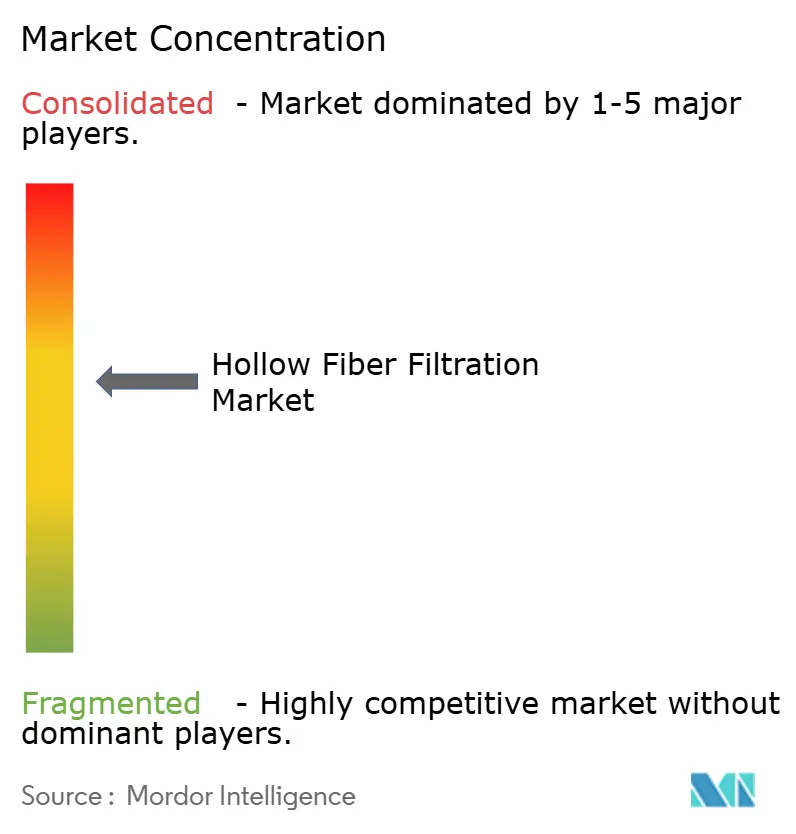


Recent Industry Developments
- February 2025: Thermo Fisher Scientific acquired Solventum’s Purification & Filtration business for USD 4.1 billion, adding 2,500 employees and an expected USD 125 million in operating income within five years.
- November 2024: Sartorius Stedim Biotech opened a Center for Bioprocess Innovation in Marlborough, Massachusetts, including two GMP suites scheduled for 2025 completion.
- November 2024: Cytiva inaugurated a 6,100 m² sterile-filtration plant in Incheon, South Korea, with future virus-filtration expansion plans.
- October 2024: Asahi Kasei Medical launched the Planova FG1 virus-removal filter delivering seven-times faster processing for monoclonal antibodies.
- September 2024: Sartorius introduced Vivaflow TFF cassettes in reusable and single-use formats for lab-scale ultrafiltration and diafiltration.
- August 2024: Boln BioTech closed nearly CNY 100 million Series A financing to advance micro- and ultrafiltration membrane production.
Global Hollow Fiber Filtration Market Report Scope
As per the scope of this report, Hollow Fiber Filtration Market is a transport and collection system used for collecting clinical specimens for diagnosis purposes. The Hollow Fiber Filtration Market is segmented by Material (Polymer, Ceramic), Technique (Microfiltration and Ultrafiltration), End User (Pharmaceutical and Biotechnology industries, Research Organizations and Contract Research Organization), and Geography ( North America, Europe, Asia-Pacific, Middle-East and Africa, and South America). The Market report also covers the estimated market sizes and trends of 17 countries across major regions globally. The report offers values in in USD million for the above segments.
| Synthetic Polymer | Polyethersulfone (PES) |
| Polyvinylidene Fluoride (PVDF) | |
| Polysulfone (PS) | |
| Polypropylene (PP) | |
| Ceramic | Alumina |
| Zirconia |
| Microfiltration | Dead-end |
| Tangential Flow (TFF) | |
| Ultrafiltration | Dead-end |
| Tangential Flow (TFF) |
| Pharmaceutical & Biotechnology |
| Contract/Clinical Research Organizations |
| Academic & Research Institutes |
| Protein Concentration & Diafiltration |
| Cell Clarification / Harvest |
| Virus / VLP Production |
| Raw Material Filtration |
| Other Applications |
| North America | United States |
| Canada | |
| Mexico | |
| Europe | Germany |
| United Kingdom | |
| France | |
| Italy | |
| Spain | |
| Rest of Europe | |
| Asia-Pacific | China |
| Japan | |
| India | |
| Australia | |
| South Korea | |
| Rest of Asia-Pacific | |
| Middle East & Africa | GCC |
| South Africa | |
| Rest of Middle East & Africa | |
| South America | Brazil |
| Argentina | |
| Rest of South America |
| By Material | Synthetic Polymer | Polyethersulfone (PES) |
| Polyvinylidene Fluoride (PVDF) | ||
| Polysulfone (PS) | ||
| Polypropylene (PP) | ||
| Ceramic | Alumina | |
| Zirconia | ||
| By Technique | Microfiltration | Dead-end |
| Tangential Flow (TFF) | ||
| Ultrafiltration | Dead-end | |
| Tangential Flow (TFF) | ||
| By End User | Pharmaceutical & Biotechnology | |
| Contract/Clinical Research Organizations | ||
| Academic & Research Institutes | ||
| By Application | Protein Concentration & Diafiltration | |
| Cell Clarification / Harvest | ||
| Virus / VLP Production | ||
| Raw Material Filtration | ||
| Other Applications | ||
| Geography | North America | United States |
| Canada | ||
| Mexico | ||
| Europe | Germany | |
| United Kingdom | ||
| France | ||
| Italy | ||
| Spain | ||
| Rest of Europe | ||
| Asia-Pacific | China | |
| Japan | ||
| India | ||
| Australia | ||
| South Korea | ||
| Rest of Asia-Pacific | ||
| Middle East & Africa | GCC | |
| South Africa | ||
| Rest of Middle East & Africa | ||
| South America | Brazil | |
| Argentina | ||
| Rest of South America | ||


Key Questions Answered in the Report
What is the projected value of the hollow fiber filtration market in 2030?
It is expected to reach USD 1.55 billion, rising from USD 0.94 billion in 2025 at a 14.53% CAGR.
Which material segment is expanding fastest in hollow fiber membranes?
Ceramic membranes are growing at a 16.75% CAGR through 2030 due to durability in harsh cleaning cycles.
Why are CDMOs important to future filtration demand?
They are forecast to hold 54% of global biologics capacity by 2028, consolidating purchasing power and favoring platformable filtration skids.
How does continuous manufacturing influence filtration design?
Perfusion bioreactors require membranes that resist fouling over multi-week campaigns, pushing vendors to develop smart, long-life modules with inline monitoring.
What is driving Asia-Pacific growth in this sector?
Government investment, rapid capacity expansion by local CDMOs, and multinational plants in South Korea and China are propelling a 15.67% regional CAGR.
Page last updated on:
